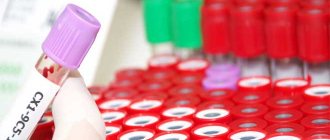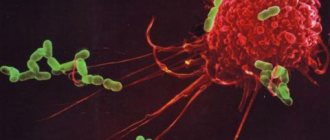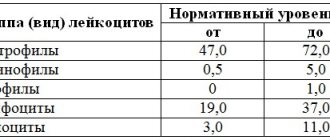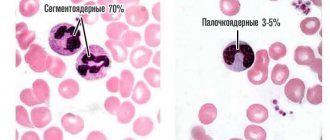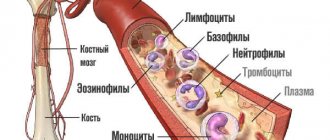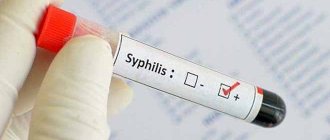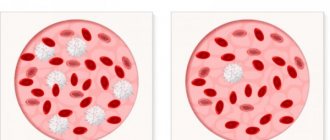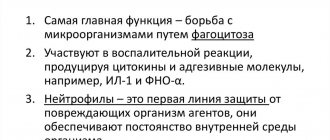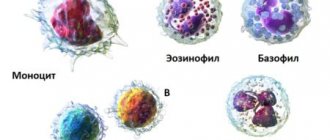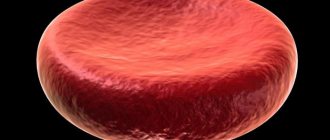General blood tests
04/09/201801/24/2019 Yulia Martynovich (Peshkova) 3159 Views lymphocytes, neutrophils, general tests
From birth, a person is protected from pathogens by the forces of natural immunity. The first line of defense is represented by immune cells that react not to a specific type of antigen, but to the very fact of the presence of foreign biomaterial (cancer cells, viruses, bacteria, microscopic fungi). The cellular type of innate immunity is represented by 5 types of leukocytes, of which neutrophil granulocytes and lymphocytes react most acutely to infection.
The number of all types of leukocytes is determined as part of an extended clinical blood test or leukocyte formula. It is important to understand what an imbalance in the blood cell ratio in adults and children indicates, especially low neutrophils and high lymphocytes.
- 1 Norms and functions of immune cells 1.1 Functions of leukocytes
- 1.2 Functions of neutrophils
- 2.1 Oncology is another cause of immune cell imbalance
Functions of neutrophils and lymphocytes
Neutrophils, commonly called neutrophilic granulocytes, live in the bloodstream for only a few hours. The renewal process takes place continuously, which allows the body to put a real barrier in the way of foreign agents.
Protection is carried out through a process called phagocytosis. Moreover, each mature neutrophil (segmented) captures and literally digests microbial particles or even whole viruses and bacteria. After which the neutrophil dies, but another one immediately takes its place.
Sometimes band neutrophils (immature) can be found in the blood. Their number is small, and they mature not in the bone marrow, like segmented ones, but in the vessels.
Lymphocytes
Lymphocytes are blood cells that are a type of white blood cell. In the body of an adult, their number reaches 40% of all other blood cells; in children this figure is even higher – 50%.
All lymphocytes are usually divided into three groups:
- B - cells.
- T - cells
- NK - cells.
Each of them performs its own function in the body. The number of these cells is strictly normalized and any deviation towards an increase or increase may indicate the development of the disease.
B – cells
These blood cells are commonly called “helpers”. Their main function is to give a signal to the rest of the cells of the immune system to strengthen or, conversely, slow down their work.
Another leading function is the production of antibodies (immunoglobulin). Antibodies are special cells that are located on the surface of B-lymphocytes and are used by the immune system not only to identify, but also to destroy foreign bodies - viruses, bacteria, microbes. The second name for this process is the immune response. With the help of these cells, humoral immunity is maintained.
T - cells
These blood cells are commonly called “killer cells”. They destroy foreign bodies at the first stage, that is, at the moment of penetration of pathogenic agents into the human body. Each such cell is trained to recognize its enemy (which may be a virus, microbe or bacteria).
If for some reason the “killers” do not cope with their work, then the “helpers” come into play. Cellular immunity is supported by T cells.
NK cells
The second name for these cells is natural killer cells. They are toxic to tumor cells, as well as those infected with viruses. Without them, innate immunity will be considered inferior.
The main function of these lymphocytes is to destroy those cells that for some reason are inaccessible to T killer cells.
What are lymphocytes and leukocytes and their significance in the blood
Lymphocytes are white blood cells and belong to a subgroup of leukocytes. In general, they are responsible for the functioning of the immune system, its memory and response in the event of penetration of harmful elements.
It is leukocytes that are the first to rush to fight foreign particles when they are detected, but if the other subgroups of this category of cells are engaged in the destruction of harmful elements, then the goal of lymphocytes can be called the destruction of themselves after the fight. Lymphocytes destroy their own cells that have undergone mutation or other damage, as well as those that have degenerated into tumor cells.
Lymphocytes exist in the blood for only a few days, after which they are divided into special subgroups in various glands of the body, each of which has its own functions.
For example, lymph nodes convert about 15% of cells into the category of B lymphocytes, which are one of the most important immune cells. It is they who, when faced with harmful elements, remember them and provide further immunity against these ailments.
In the thymus, approximately 80% of cells are converted into the category of T-lymphocytes, divided into subtypes: T-suppressor, T-heller and T-killer, each of which has its own functions aimed at destroying harmful elements and maintaining the immune system.
NK lymphocytes make up only about 5%, but they are responsible for destroying their own damaged cells. Clusters of dead cells form pus.
In general, all white blood cells play the role of providing the body's natural defenses and maintaining the normal functioning of the immune system.
The value of normal indicators
In the analysis form, the normal neutrophil count is most often written as a percentage. Normally, the indicator of segmented neutrophils will be from 47 to 72. If we talk about absolute indicators, then there will be other numbers - from 2.0 to 5.5 per 109 per liter.
There may be no band neutrophils at all, that is, in the form opposite this indicator there may be the number 0. But this rarely happens. Typically, the normal amount of these cells is from 1 to 6%.
The number of lymphocytes in a normal blood test will range from 19 to 37%. But most often the absolute value is written on the form from the laboratory, which ranges from 1.2 to 3.0 per 109 per liter.
The norm of lymphocytes and neutrophils in men and women does not have any difference in indicators. But a child's blood test will normally be different.
In children, the percentage of neutrophils is lower than in adults.
- Up to 12 months, this figure will be from 30 to 50.
- For children from one to six years old, the numbers will be different - from 35 to 55.
- At the age of 6 to 13 years, the number of neutrophils approaches the adult value - from 40 to 60.
The number of lymphocytes in the blood of a child is greater than that of an adult. Up to a year, this figure should not exceed 40 - 60%; from one to five years the numbers will be different - from 45 to 65%. And for older children this figure is 30–45%.
Reasons for decreased neutrophils
Even a slight decrease in neutrophils in the blood will be called neutropenia. It can be both pathological and physiological. In the first case, the cause is always a disease.
Physiological neutropenia can occur during intense physical activity, immediately after eating, during stress, or during pregnancy.
There is no threat to life with physiological neutropenia, and soon all numbers return to normal.
Pathological neutropenia requires additional examination to determine the reasons for the development of this condition. Typically, a low number of neutrophils in a blood test is observed with:
- Chronic inflammatory disease of long duration.
- Severe infections, including hepatitis, HIV and AIDS.
- Fungal infection of a generalized nature.
- Infection with parasites (toxoplasmosis, malaria).
- Some hereditary diseases (Kostman syndrome).
- Exposure to radiation.
- A course of chemotherapy.
- Allergic reaction, especially with anaphylactic shock.
- Poisoning with poisons and chemical compounds.
- Damage to the bone marrow by cancer, metastases.
Sometimes a decreased level of neutrophils can be observed when taking chloramphenicol, zidovudine, or sulfonamide antibiotics. This is not a reason to cancel treatment.
Diagnostics
Lymphocytes and neutrophils are blood cells that perform vital functions and can tell a lot about the patient’s condition. In order not to miss the development of serious diseases, it is necessary to take a general blood test annually. Leukocytes are determined according to special standard standards. The identified discrepancy characterizes the high activity of blood cells and signals the beginning of the development of pathological processes. Based on the results of the study, even hidden, asymptomatic diseases can be detected.
The analysis requires capillary blood from the patient. They take it in the morning, strictly on an empty stomach, having eliminated smoking and alcohol for several days. You should inform your doctor in advance about taking vital medications. The patient should be as calm as possible physically and psychologically before collecting the material. Only a specialist can correctly decipher the results of the study. He evaluates all hemotest indicators in aggregate. The leukocyte formula deserves special attention, reflecting the ratio of individual types of leukocytes in percentages and numbers. Leukocyte calculation allows you to determine the number of white blood cells per unit volume. The content of some fractions changes due to an increase or decrease in others.
An extended blood test with leukocyte count is required for patients with:
- acute infectious and inflammatory diseases,
- immunodeficiency conditions,
- frequent relapses of bacterial and fungal infections,
- pregnant women.
By analyzing a high or low percentage of white blood cells, the doctor may suspect a patient has a rare autoimmune disorder, hematological disease, or immunodeficiency. Based on the leukocyte formula, one can draw a conclusion about the development of complications, the course of the pathological process and the prognosis of the disease. Using leukogram results, doctors differentiate between viral and bacterial infections.
- Viral damage is characterized by an increase in lymphocytes and a decrease in neutrophils.
- Infectious diseases caused by bacteria are manifested by a shift in the leukocyte formula to the left - an increase in neutrophilic leukocytes and a relatively low content of lymphocytes.
Laboratory indicators do not allow making a final diagnosis of the existing pathology. To do this, it is necessary to conduct a more detailed examination of the patient, including clinical signs, anamnestic data, instrumental methods and a whole list of analyzes of biological material.
To determine the cause of the disorder, the doctor needs to find out:
- patient complaints,
- objective signs,
- anamnesis,
- heredity.
Taking certain medications can affect the number of certain fractions of leukocytes in the blood . These include antibiotics, antihistamines, diuretics, corticosteroids, anticoagulants, and muscle relaxants. It is necessary to inform the doctor about the treatment performed. Chemotherapy and radiation therapy also cause an increase in the proportion of white cells in the blood. A prolonged decrease in neutrophils and an increase in lymphocytes require additional examinations - blood tests for tumor markers, tomographic, radiographic and ultrasound examinations of internal organs.
After receiving the results of tests and tests, the doctor makes a final diagnosis and draws up a treatment plan.
Basis for increasing lymphocytes
An increase in lymphocytes is called lymphocytosis. It can also be physiological or pathological. In the first case, the basis for the increase should be considered hard physical work and menstruation in women.
Pathological lymphocytosis is observed in all infections, both in childhood (chickenpox, chicken pox, whooping cough) and in adults (influenza, ARVI). Other reasons for increased lymphocytes in the blood include:
- Infectious mononucleosis.
- Cytomegalovirus infection.
- Transition from acute to chronic disease.
- The stage of inflammation subsiding.
- Bacterial infections.
- Autoimmune diseases.
- Acute immediate allergic reaction (anaphylaxis).
- Malignant and benign tumors.
Severe lymphocytosis is characteristic of chronic lymphocytic leukemia and Waldenström macroglobulinemia.
Lymphocytosis is usually divided into relative and absolute.
Relative lymphocytosis occurs when lymphocytes remain normal, but displace neutrophils and their percentage is reduced to the minimum possible. This happens with diseases of the joints of a rheumatic nature, with increased levels of thyroid hormones or with an increase in the size of the spleen (splenomegaly).
Absolute lymphocytosis is an increase in the number of lymphocytes at other norms. This occurs with toxoplasmosis, viral pneumonia, tuberculosis, syphilis, brucellosis and diphtheria.
Reasons for decreased neutrophils and increased lymphocytes
The main reason for the increase in lymphocytes and decrease in neutrophils in the blood test should be considered infections. They can be caused by viruses or bacteria. Often such an analysis can be obtained at the incubation stage, that is, when there are no symptoms of the disease yet, but the microbe has already entered the body, and the immune system has begun to fight it.
Few neutrophils can also be observed during an allergic reaction. Based on these indicators, allergists can accurately tell whether a person has a tendency to be allergic, for example, to poplar fluff in the spring or to pollen. The patient himself may not be aware that he has a high risk of developing an allergic reaction.
A lot of lymphocytes in the blood often indicates an acute course of the disease. This can be either influenza or acute respiratory viral infection, or tuberculosis, systemic lupus erythematosus, lymphogranulomatosis, or kidney disease.
And finally, such a blood test can be obtained in the event of the development of an abscess, phlegmon, abscess, gangrene, heart attack or stroke. Therefore, to make an accurate diagnosis, the number of neutrophils and lymphocytes in the blood alone will not be enough.
Interpretation of analyzes
There are some standards in the blood test for neutrophils; any discrepancy indicates increased activity of these bodies and the formation of pathology. When examining a similar situation, the presence of mature and immature neutrophils is revealed. Their indicator is determined only by the patient’s age and does not depend on his gender.
Important information: What is PDW or platelet population distribution width and deciphering the norm in a general blood test
According to the standards, stab neutrophil granulocytes in adults should not exceed 1-4, and segmented ones - 40-60. Moreover, both their number and the percentage ratio between them are important.
If an increase in lymphocytes in the blood is detected, we can talk about the development of inflammation. Taking into account the presence of concomitant diseases, the doctor will be able to tell in which area the disease is localized. Against the background of an increase in leukocytes in acute pathology, an increase in neutrophils in the blood is observed, this is always evidence that:
- inflammation in the internal system, accompanied by a purulent process in the form of generalized disorders - sepsis, peritonitis, cholera or localized - tonsillitis, scarlet fever or pyelonephritis;
- necrotic processes in the form of heart attacks, strokes, extensive burns or frostbite, gangrene;
- alcohol or lead poisoning;
- malignant neoplasm.
When there are a lot of neutrophilic granulocytes in the bloodstream, all the indices are added up, which makes it possible to determine the level of development of the disease. He can be:
- moderate - within 10*109/l;
- pronounced - 10-20 *109/l;
- elevated - 20-60*109/l.
Results indicating a decrease in neutrophils and an increase in lymphocytes are normal for a child; indicators at this age are different from the standard figures for an adult.
Lymphocytes in the blood are still elevated, and neutrophils are decreased as a result of immunization. The immune system reacts to the vaccine as a foreign substance and begins to produce antibodies, but neutrophil granulocytes do not attack it because the pathogen is incapacitated (does not lead to the development of the disease).
In an adult, segmented neutrophils are reduced and lymphocytes are increased against the background of the following conditions:
- exhausted body;
- bacterial infection, due to which many neutrophil granulocytes died (for example, with rubella, hepatitis, measles);
- pathologies (typhoid, brucellosis);
- blood diseases;
- therapy with chemotherapy drugs and radio wave irradiation.
When lymphocytes are increased and neutrophils are decreased, this indicates that the body is resisting the disease, and the pathogenic agent has already been defeated, so killer cells do not attack, but have begun to normalize their level. The composition of the blood flow stabilizes gradually, so some deviations in the leukocyte formula are determined.
Normal indicators
In the form with test results, neutrophil granulocytes are indicated as a percentage. According to standards, mature neutrophils in the blood should not exceed 47-72%. As for the absolute numbers, they look like this - 2.0-5.5 * 109/l.
Immature neutrophils may be completely absent (on the form next to this indicator there will be a value of “0”). Although such a phenomenon is rare. These bodies should typically have a value of a maximum of 1-6%.
According to standards, lymphocytes in the bloodstream should be no more than 19-37%. Although the results indicate absolute numbers - 1.2-3.0*109/l.
The number of neutrophils and lymphocytes does not depend on the gender of the person, and the standards for these indices in children and adolescents are slightly different. According to standards, neutrophil granulocytes in children are:
- under one year of age - 30-50;
- 1-6 years - 35-55;
- at 6-13 - closer to the adult index (40-60).
Important information: What does an increase in hematocrit in the blood of an adult mean and what does it mean (causes and treatment)
Lymphocytes in the bloodstream of a child are slightly higher when compared to adults. Before reaching the age of one year, according to the standards, these bodies should be 40-60%; at 1-5 years - 45-65%; after 5 years - 30-45%.
Deviations
If neutrophil counts are low and lymphocyte counts are high in an adult, this sometimes indicates an acute viral infection, but individually these data do not make it possible to accurately diagnose the disease. To establish a definitive diagnosis, it is necessary to take into account the clinical picture of the disease and diagnostic data individually.
The doctor is required to decipher the laboratory test results.
You should not make a diagnosis or prescribe medications on your own. If you delay visiting a specialist to prescribe appropriate treatment, there is a possibility of worsening the situation, including death.
Experts call a decrease in mature neutrophil granulocytes neutropenia, and an increase in lymphocytes - lymphocytosis. Increased lymphocytes and decreased neutrophils in women and men are observed against the background of viral or bacterial infection. Particularly dangerous are extensive infections in which a pathogenic agent penetrates the hematopoietic system. In this case, the bone marrow does not produce the required amount of neutrophils, which die upon contact with the pathogen. This condition is characterized by the appearance of signs characteristic of intoxication:
- sudden increase in temperature;
- weaknesses;
- clouded consciousness;
- tachycardia;
- rapid breathing;
- lowering blood pressure.
If symptoms characteristic of an acute infectious infection or sepsis appear, you should immediately consult a doctor. In this case, the patient is placed in a hospital under constant medical supervision. Such actions will help prevent septic shock, which can cause the death of the patient.
Treatment
Neutropenia in both children and adults cannot be mistaken for a separate disease. This is just one of the symptoms of an acute or chronic inflammatory process.
Low neutrophils are not cured with one pill. Therapy should only be comprehensive and carried out after identifying the reasons for the appearance of abnormalities in the blood test. And self-medication can be not only useless, but also life-threatening.
High lymphocytes in some cases can be considered as a variant of the norm, but only in the absence of other symptoms or changes in the leukocyte blood count. In a child, lymphocytosis is physiological in nature, especially in the first year of life, and does not require any treatment. Unless the doctor deems it necessary to carry out any medical procedures.
If neutrophils are low in an adult, but lymphocytes remain elevated, this may indicate an acute inflammatory process, the presence of benign or malignant tumors in the body, as well as incipient tuberculosis. To clarify the diagnosis, you need to visit a doctor and conduct additional research.
Neutrophils are increased, but lymphocytes are decreased
The main reason for low lymphocytes and high neutrophils is the accelerated destruction of lymphocytes during prolonged viral infections and severe inflammatory diseases.
The immune system compensates for decreased lymphocytes with increased segmented neutrophils and enhances their activity. Similar changes in the leukocyte formula are observed in the initial acute period of infection, which can last more than a week.
If in adults neutrophils and leukocytes are increased, but lymphocytes are decreased to levels lower than normal, then this indicates kidney disease, liver disease, or a tumor process.
Features of blood parameters in pregnant women
A change in the leukocyte formula of the blood, when segmented neutrophils are increased and lymphocytes are decreased, but total leukocytes are normal, is noted during pregnancy.
In pregnant women, an increase in total leukocytes due to an increase in the number of mature segmented neutrophils is the norm. In this way, a woman’s immune system reacts to the presence and development of the fetus.
This change in the leukocyte formula is caused by the fact that as the fetus grows in the placenta, the need arises to dispose of its waste products.
A temporary increase in the neutrophil population during pregnancy can be caused by:
- vomit;
- exercise stress;
- pain;
- infectious respiratory diseases.
If both segmented and band neutrophils increase in the blood of a pregnant woman, this may serve as an indicator of the threat of termination of pregnancy in the later stages.
